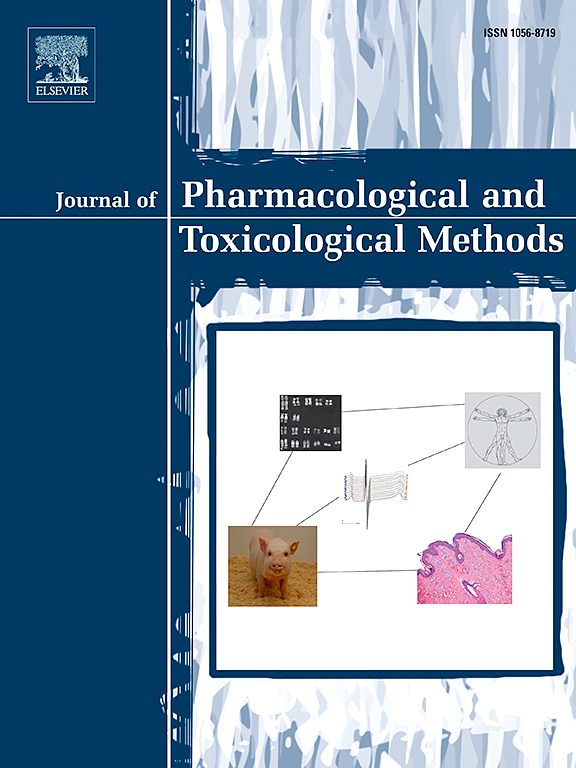Best practice considerations for nonclinical in vivo cardiovascular telemetry studies with alternative study designs in non-rodent species
IF 1.3
4区 医学
Q4 PHARMACOLOGY & PHARMACY
Journal of pharmacological and toxicological methods
Pub Date : 2025-05-01
DOI:10.1016/j.vascn.2025.107607
引用次数: 0
Abstract
The recently published ICH E14/S7B Q&As incorporated an additional thorough QT (TQT) substitution path for compounds that are double negative in nonclinical studies (hERG and in vivo QT). To increase regulatory confidence in such an approach, general requirements for nonclinical telemetry studies were detailed in the Q&As that focus on model sensitivity, data analysis techniques, and clinical translation. Briefly, criteria for the integrated risk assessment include prescriptive in vitro hERG requirements, and an in vivo evaluation at sufficient multiples over the highest clinical exposure with demonstrated adequate sensitivity to detect an effect of a similar magnitude as a dedicated clinical QT study. Harmonization of best practices for a Latin square crossover study design were recently published by industry subject matter experts (SMEs) to ensure high quality QTc data to support an ICH E14/S7B Q&A 5.1 scenario that meets regulatory expectations. However, there is no industry consensus on best practices for alternate study designs (ascending dose, parallel groups, etc.) routinely utilized for oncology small molecule, large molecule, oligonucleotide, and peptide modalities. To increase industry consistency and ensure data quality, SMEs are collaborating to review current methodologies for alternative study designs where continuous data collection is required in implanted and jacketed telemetry studies. A survey was generated by members of the working group to gather information on alternative study designs employed, data analysis processes, QT interval correction and statistical methods, individual study and test facility sensitivity, and use of pharmacokinetic sampling. The most common current alternative designs included escalating dose (vehicle plus 3 doses levels, N = 4) and parallel (2–3 treatment groups plus concurrent vehicle, N = 4–8/group) which have been submitted to satisfy the ICH S7B, S6, S9, and to a limited extent, the S7B 5.1/6.1 Q&As. Escalating dose designs were typically applied to small molecules, whereas parallel designs were used to test oligonucleotides, large and small molecules. Data from this survey will be used as a starting point for the working group to recommend best practices for alternate study designs in the context of supporting the ICH E14/S7B Q&A 5.1 and 6.1 scenarios and build regulatory confidence in nonclinical QTc data.
非临床体内心血管遥测研究的最佳实践考虑与非啮齿动物物种的替代研究设计
最近发表的ICH E14/S7B Q&;As纳入了非临床研究(hERG和体内QT)双阴性化合物的额外彻底QT (TQT)替代途径。为了增加对这种方法的监管信心,Q&;As中详细介绍了非临床遥测研究的一般要求,重点是模型敏感性、数据分析技术和临床翻译。简而言之,综合风险评估的标准包括体外hERG的规定要求,以及在最高临床暴露的足够倍数的体内评估,显示出足够的灵敏度,以检测与专门的临床QT研究相似程度的影响。行业主题专家(sme)最近发布了拉丁方交叉研究设计最佳实践的协调,以确保高质量的QTc数据支持ICH E14/S7B Q&; a 5.1场景,满足监管期望。然而,对于常规用于肿瘤小分子、大分子、寡核苷酸和肽模式的替代研究设计(递增剂量、平行组等)的最佳实践,业界尚无共识。为了提高行业一致性并确保数据质量,中小企业正在合作审查现有的替代研究设计方法,在植入式和夹套式遥测研究中需要连续收集数据。工作组成员进行了一项调查,以收集所采用的替代研究设计、数据分析过程、QT间期校正和统计方法、个体研究和测试设备敏感性以及药代动力学抽样的使用等方面的信息。目前最常见的替代设计包括递增剂量(载药加3个剂量水平,N = 4)和平行(2-3个治疗组加并发载药,N = 4 - 8/组),这些设计已提交以满足ICH S7B、S6、S9,并在一定程度上满足S7B 5.1/6.1 Q& a。递增剂量设计通常应用于小分子,而平行设计用于测试寡核苷酸,大分子和小分子。该调查的数据将作为工作组在支持ICH E14/S7B Q&; a 5.1和6.1情景的背景下推荐替代研究设计的最佳实践的起点,并建立对非临床QTc数据的监管信心。
本文章由计算机程序翻译,如有差异,请以英文原文为准。
求助全文
约1分钟内获得全文
求助全文
来源期刊

Journal of pharmacological and toxicological methods
PHARMACOLOGY & PHARMACY-TOXICOLOGY
CiteScore
3.60
自引率
10.50%
发文量
56
审稿时长
26 days
期刊介绍:
Journal of Pharmacological and Toxicological Methods publishes original articles on current methods of investigation used in pharmacology and toxicology. Pharmacology and toxicology are defined in the broadest sense, referring to actions of drugs and chemicals on all living systems. With its international editorial board and noted contributors, Journal of Pharmacological and Toxicological Methods is the leading journal devoted exclusively to experimental procedures used by pharmacologists and toxicologists.
 求助内容:
求助内容: 应助结果提醒方式:
应助结果提醒方式:


